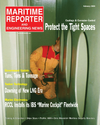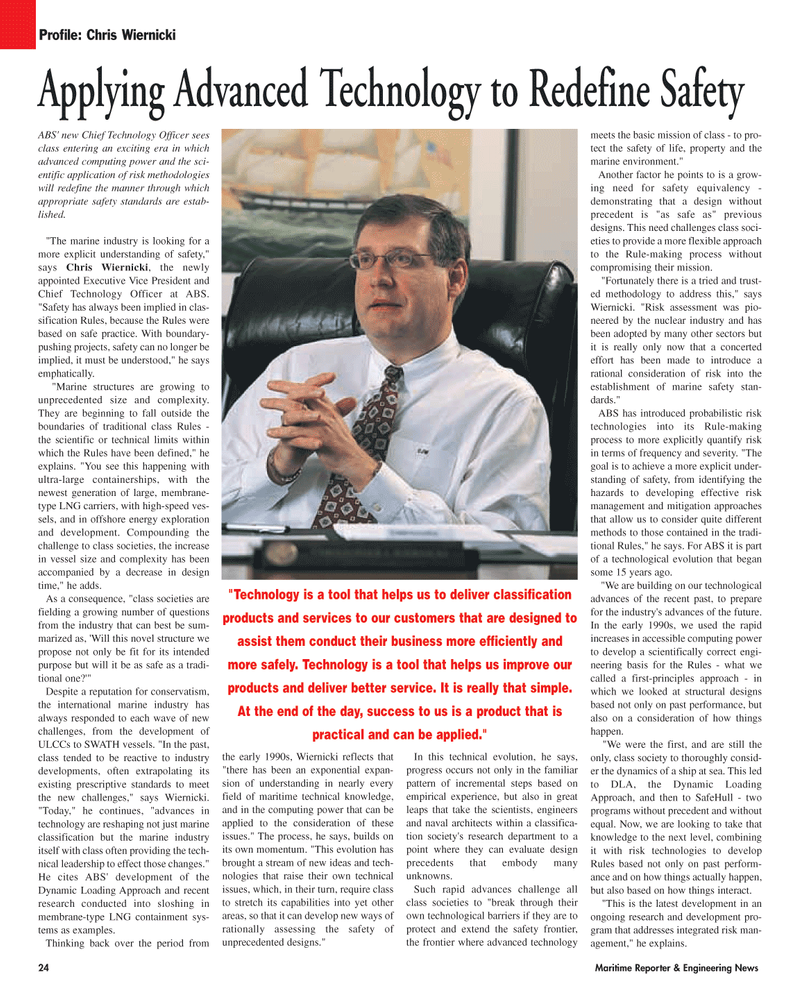
Page 24: of Maritime Reporter Magazine (February 2, 2005)
Read this page in Pdf, Flash or Html5 edition of February 2, 2005 Maritime Reporter Magazine
24 Maritime Reporter & Engineering News
ABS' new Chief Technology Officer sees class entering an exciting era in which advanced computing power and the sci- entific application of risk methodologies will redefine the manner through which appropriate safety standards are estab- lished. "The marine industry is looking for a more explicit understanding of safety," says Chris Wiernicki, the newly appointed Executive Vice President and
Chief Technology Officer at ABS. "Safety has always been implied in clas- sification Rules, because the Rules were based on safe practice. With boundary- pushing projects, safety can no longer be implied, it must be understood," he says emphatically. "Marine structures are growing to unprecedented size and complexity.
They are beginning to fall outside the boundaries of traditional class Rules - the scientific or technical limits within which the Rules have been defined," he explains. "You see this happening with ultra-large containerships, with the newest generation of large, membrane- type LNG carriers, with high-speed ves- sels, and in offshore energy exploration and development. Compounding the challenge to class societies, the increase in vessel size and complexity has been accompanied by a decrease in design time," he adds.
As a consequence, "class societies are fielding a growing number of questions from the industry that can best be sum- marized as, 'Will this novel structure we propose not only be fit for its intended purpose but will it be as safe as a tradi- tional one?'"
Despite a reputation for conservatism, the international marine industry has always responded to each wave of new challenges, from the development of
ULCCs to SWATH vessels. "In the past, class tended to be reactive to industry developments, often extrapolating its existing prescriptive standards to meet the new challenges," says Wiernicki. "Today," he continues, "advances in technology are reshaping not just marine classification but the marine industry itself with class often providing the tech- nical leadership to effect those changes."
He cites ABS' development of the
Dynamic Loading Approach and recent research conducted into sloshing in membrane-type LNG containment sys- tems as examples.
Thinking back over the period from the early 1990s, Wiernicki reflects that "there has been an exponential expan- sion of understanding in nearly every field of maritime technical knowledge, and in the computing power that can be applied to the consideration of these issues." The process, he says, builds on its own momentum. "This evolution has brought a stream of new ideas and tech- nologies that raise their own technical issues, which, in their turn, require class to stretch its capabilities into yet other areas, so that it can develop new ways of rationally assessing the safety of unprecedented designs."
In this technical evolution, he says, progress occurs not only in the familiar pattern of incremental steps based on empirical experience, but also in great leaps that take the scientists, engineers and naval architects within a classifica- tion society's research department to a point where they can evaluate design precedents that embody many unknowns.
Such rapid advances challenge all class societies to "break through their own technological barriers if they are to protect and extend the safety frontier, the frontier where advanced technology meets the basic mission of class - to pro- tect the safety of life, property and the marine environment."
Another factor he points to is a grow- ing need for safety equivalency - demonstrating that a design without precedent is "as safe as" previous designs. This need challenges class soci- eties to provide a more flexible approach to the Rule-making process without compromising their mission. "Fortunately there is a tried and trust- ed methodology to address this," says
Wiernicki. "Risk assessment was pio- neered by the nuclear industry and has been adopted by many other sectors but it is really only now that a concerted effort has been made to introduce a rational consideration of risk into the establishment of marine safety stan- dards."
ABS has introduced probabilistic risk technologies into its Rule-making process to more explicitly quantify risk in terms of frequency and severity. "The goal is to achieve a more explicit under- standing of safety, from identifying the hazards to developing effective risk management and mitigation approaches that allow us to consider quite different methods to those contained in the tradi- tional Rules," he says. For ABS it is part of a technological evolution that began some 15 years ago. "We are building on our technological advances of the recent past, to prepare for the industry's advances of the future.
In the early 1990s, we used the rapid increases in accessible computing power to develop a scientifically correct engi- neering basis for the Rules - what we called a first-principles approach - in which we looked at structural designs based not only on past performance, but also on a consideration of how things happen. "We were the first, and are still the only, class society to thoroughly consid- er the dynamics of a ship at sea. This led to DLA, the Dynamic Loading
Approach, and then to SafeHull - two programs without precedent and without equal. Now, we are looking to take that knowledge to the next level, combining it with risk technologies to develop
Rules based not only on past perform- ance and on how things actually happen, but also based on how things interact. "This is the latest development in an ongoing research and development pro- gram that addresses integrated risk man- agement," he explains.
Profile: Chris Wiernicki
Applying Advanced Technology to Redefine Safety "Technology is a tool that helps us to deliver classification products and services to our customers that are designed to assist them conduct their business more efficiently and more safely. Technology is a tool that helps us improve our products and deliver better service. It is really that simple.
At the end of the day, success to us is a product that is practical and can be applied."
MR FEBRUARY 2005 #3 (17-24).qxd 2/2/2005 9:37 AM Page 8

 23
23

 25
25
